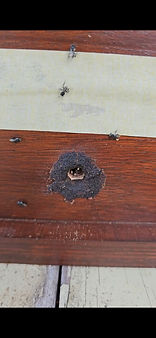How we remove native bees
Assessment and removal
-
Removals are best scheduled for the afternoon when most native bees have returned to roost. We understand this can be inconvenient and we will work with you on how we can ensure most native bees are in the nest before removal, at a time convenient to you.
-
An inspection of the hive is conducted to determine the best removal method and any potential hazards.
-
We carefully extract the nest from its current location without causing harm to the native bees.
-
The nest, along with food stores, is transferred to a new OATH hive. giving the best chance of survival.

Collection
-
Once the nest is relocated in its new hive, we provide the native bees with a small amount of honey pots and pollen to feed on.
-
To gather any remaining native bees that may have been missed during the transfer, we use a purpose made vacuum. This method is safe for the native bees as the suction is carefully calibrated to transport them to a holding container without causing harm.
-
The new hive is sealed to protect the colony. We then return to the original nest site to vacuum any remaining native bees that may have settled.
-
The remaining structure of the old nest is cleaned up. This often includes native bee wax and propolis, which can be repurposed and placed around the entrance of the new hive. This helps the bees recognise their new home and provides them with valuable building materials.

Final steps
-
The bees are taken to our property where they are monitored for survival.
-
We strive to make sure we remove all the native bees, but some may remain and return to the original site. They may rebuild a new nest near the original site. If this occurs, we can schedule another removal.
-
Native bees are generally harmless and play a vital role in our ecosystem. Even if their presence may be inconvenient for some, they are import to our ecological system.

